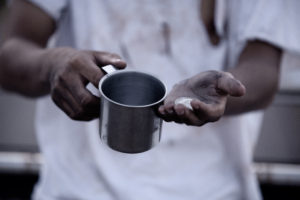The term interiorization refers to voluntarily taking Venezuelan refugees and migrants from the state of Roraima to other cities in the country offering better opportunities for socioeconomic insertion. This, in turn reduces the pressure on public services in the state of Roraima.
The federal government estimates around 260,000 Venezuelan refugees and migrants currently live in Brazil. The vast majority of them enter the country through Pacaraima in the state of Roraima on the border with Venezuela, a small town of 17,000 inhabitants that lives with approximately 500 Venezuelans crossing its border every day.
Most Venezuelans head to Boa Vista, the capital of the state of Roraima, 215km away from Pacaraima, with 420,000 inhabitants. It is estimated that Venezuelans already represent 10% of the city’s population.
This is a new situation for both cities since Venezuela has been facing an economic and humanitarian crisis since 2014 with the migratory flow intensifying in 2016 and remaining strong until 2020 when the borders were closed due to the pandemic.
The state of Roraima, where both cities are located, has the lowest GDP in the country, in addition to being the state with the lowest demographic density. As a result, public infrastructure and services in these cities have been impacted by the rapid and growing contingent of migrants and refugees.
One of the ways found to welcome refugees and migrants without overloading the infrastructure of these cities is the process of interiorization, sending them to other cities in the country.
The Brazilian Federal Government, with the support of UNHCR (UN Refugee Agency), IOM (International Organization for Migration), other United Nations agencies and civil society entities, are responsible for the “Operação Acolhida” program which has already internalized 50,000 people since its start in April 2018.
A survey conducted by UNHCR (UN Refugee Agency) with 360 Venezuelan families that benefited from by this program, revealed that 77% of them found employment a few weeks after arriving in the destination cities (against 7% with employment before). Most already had enough income to pay rent and all families had at least one child in school (versus 65% before).
To know more, visit: https://www.acnur.org/portugues/2021/04/20/interiorizacao-beneficia-mais-de-50-mil-refugiados-e-migrantes-da-venezuela-no-brasil/
The program is well-structured, and the results are encouraging.
The city of Manaus, in the state of Amazonas, is the financial and commercial center of the northern region of the country and is 750km from Boa Vista. For this reason, it is the destiny of many Venezuelans in search of better living conditions and job opportunities. Some of them reach Manaus through the interiorization program.
Manaus was one of the cities most impacted by COVID, and combined with crowded shelters and an unstable economy, an increasing number of Venezuelans found themselves without a source of income and without a place to live. Asking for money at traffic lights and living on the streets became the only one option available for a significant number of people.
Once interiorized from Boa Vista to Manaus, a new interiorization to another city can be complex.
Regions in the South and Southeast with the highest GDP in the country are especially abundant in job opportunities for these refugees and migrants. However, it is necessary to build a connection with them from Roraima so that the process of internalization is carried out only once. There are NGOs connecting Venezuelans in Boa Vista with the private sector in other states, but due to the high number of people and the recent need, they are unable to meet all the demand. This cooperation helps to combine the Venezuelans’ needs and companies’ demand for workers, as they have been expanding their production capacity, but often do not find enough workers in their location to fill all the vacancies. This was the case in Dourados (MS), where 2,517 Venezuelans have been welcomed, and Chapecó (PR), which has already received 1,056, where the food industry, especially slaughterhouses, required more workers.
São Paulo is more than 3,000 km away from Boa Vista, and this distance makes awareness of the situation experienced by refugees low in the southern states, where we see a small Venezuelan community.
Even so, of the 50,000 interiorized by “Operação Acolhida”, 8,000 have moved to the State of São Paulo and almost 25,000 to the 3 southern states.
Among the people we have been in contact with through AIRE, we have received cases of people who have already been interiorized once from Boa Vista to Manaus and are facing difficulties being interiorized once again, others who did not have the necessary documents to apply for this program, and some who used their savings to buy a flight ticket. All mention the difficulty of finding job opportunities in Manaus and Boa Vista at this moment as the main reason for moving towards the south of the country.
AIRE has sought to create a collaborative network to help them find new job opportunities. In general, they are seeking financial independence for housing, providing a better future for their children, and bringing the rest of the family that stayed in Venezuela to Brazil or, alternatively, sending money regularly to support them.
Access to formal employment is considered one of the main indicators of the success of interiorization, as it generates stability, integration into the society and dignity.



